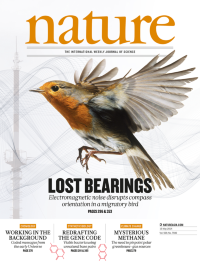Volume 509
-
No. 7501 22 May 2014
A conjugating pair of Paramecium cells visualized by confocal microscopy: the mating-type O cell was transformed to express fluorescent-labelled ciliary protein (shown in yellow), and both O and E cells are decorated with the TAP952 anti-monoglycylated tubulin antibody (shown in red). The protozoan Paramecium, widely studied as a typical ciliate, multiplies asexually by binary fission much of the time, but under certain conditions will reproduce sexually. Two mating types, E and O, were discovered in 1937 but only now has the molecular basis for maternal inheritance of mating type been elucidated. Eric Meyer and colleagues show in Paramecium tetraurelia that mating type E depends on expression of the transmembrane protein mtA, and the default type O is determined during development by excision of the mtA promoter by scnRNAs, a class of small scan� RNA that reprograms the Paramecium genome during sexual reproduction by recognizing and excising transposable elements. A similar switch mechanism, involving a different gene, mtB, has evolved independently in a sibling species P. septaurelia, implying that exaptation of the scnRNA pathway may be a general mechanism for transgenerational epigenetic inheritance of differentiated states in Paramecium. Cover: Anne Aubusson-Fleury /Centre de Génétique Moléculaire Gif-sur-Yvette.
-
No. 7500 15 May 2014
Many migrating birds rely on the Earths magnetic field for their sense of direction, although what mechanism they use to detect this extraordinarily weak field is unknown. Following the surprise observation that night-migratory songbirds (European robins) tested between autumn 2004 and autumn 2006 in wooden huts on the University of Oldenburg campus seemed unable to orient in the appropriate migratory direction, Henrik Mouritsen and colleagues performed controlled experiments to establish what was happening. They find that robins lose the ability to use the Earths magnetic field when exposed to low-level AM electromagnetic noise between around 20 kz and 20 MHz, the kind of noise routinely generated by consumer electrical and electronic equipment. Interestingly, the magnetic component of this electromagnetic noise is a thousand times weaker than the lower exposure limits adopted in current World Health Organization (WHO) guidelines, yet it can disrupt the function of an entire sensory system in a higher vertebrate. The birds regain the ability to orient to the Earths magnetic field when they are shielded from electromagnetic noise in the frequency range from 2 kHz to 5 MHz or when tested in a rural setting. Credit: Kim TaylorDorling KindersleyGetty/ Karl HarrisonHenrik Mouritsen





